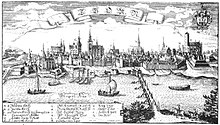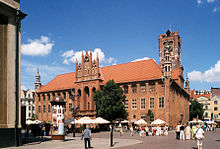Old town of Toruń
| Old town of Toruń | |
|---|---|
|
UNESCO world heritage |
|

|
|
| Old town with St. John's Cathedral |
|
| National territory: |
|
| Type: | Culture |
| Criteria : | (ii, iv) |
| Reference No .: | 835 |
| UNESCO region : | Europe and North America |
| History of enrollment | |
| Enrollment: | 1997 (session 21) |
The old town of Toruń ( Zespół staromiejski Torunia ) in the northern Polish city of Toruń ([ ˈtɔruɲ ] ; German Thorn ) was declared a UNESCO World Heritage Site in 1997 . With the exception of one street from the late 19th century, almost all of the buildings are medieval. The historical area consists of the old town (city law 1231/1233) and the new town, which was created as a craftsmen's settlement (city law 1246). The ruined castle of the Teutonic Order lies between the two .
Thorn in the Middle Ages
Foundation and relocation
In 1231 a settlement of the Teutonic Order was established in Alt-Thorn (today Stary Toruń / Starotoruńskie Przedmieście ) as one of the first in the Kulmer Land . The name may have been taken from the Crusader fortress of Toron in the Holy Land . On December 28, 1233, the city was granted city rights with the Kulmer Handfeste , the first city in Prussia. German settlers came from Westphalia .
In 1236 the place was relocated about 7.5 kilometers further east, probably because the location was too humid. The first churches were built. Franciscans came to the city as early as 1239/41 , in whose monastery the church administration of Prussia was decided at a synod in 1243. Thorn Castle was built in 1260 . In 1263 a Dominican and a Cistercian convent were built . The new town was founded in 1264, with its own city council and coat of arms.
Hanseatic city and disputes with the Teutonic Order
In the 14th century Thorn joined the Hanseatic League , as did Elbing , Danzig , Königsberg i. Pr. And Kulm . Since 1367 it belonged to the Cologne Confederation of the Hanseatic League. There were disputes between the city and the Teutonic Order, who wanted to control the trade. In the First Peace of Thorn in 1411, agreements were made between the Kingdom of Poland and the Teutonic Order. Thorn joined together with other cities in 1440 to form the Prussian Confederation . In 1454 the Ordensburg in Thorn was conquered and destroyed by the city. This year the old town and new town were merged into one city. After the Second Peace of Thorn in 1466, the city came to the Kingdom of Poland in Prussia Royal Share .
The most famous son of the city, the future astronomer Nicolaus Copernicus , was born into a merchant family in 1473 . In Thorn he attended the Johannis School, a Latin school at the St. Johannis Church in the old town.
Thorn in the 17th century
In 1684 a representation of the old and new town of Thorn and the castle was published.
- A. S. Johannis Kirch
- BS Jacobs Kirch
- C. S. Marien Kirch u. high school
- D. Dominican monastery
- E. Monastery of the Holy Spirit
- FS Laurenz Kirch
- G. Alt Stättisch Town Hall
- H. Neu Stättisch Town Hall
- I. Alt Schloßberg
- K. Alt Thornisch Thor
- L. Culmisch Thor
- MS Catharinen Thor
- N. Holt Thor
- O. Sloser (?) Thor
- P. castle port
- Q. The island
Architectural monuments of the old town
Medieval churches
- Jakobskirche, Gothic hall church, built in 1309, parish church in Neustadt
- Marienkirche , Gothic brick hall church, 14th century
- St. John's Cathedral, cathedral church, three-aisled Gothic brick basilica, 15th century, with chapels, paintings, epitaphs and Tuba Dei , the second largest bell in Poland
- ( Nikolaikirche , built in 1343, demolished in 1834)
- (Georgenkirche, no longer available)
Old Town Hall
The large building on the old town market in the brick Gothic was built in the 13th century and rebuilt in the Baroque style over the years until the 18th century. In the 19th century the town hall was raised by one floor, so sensitively that only the initiated will notice. It used to be an administrative and commercial center, now it is home to the local museum. The town hall has a 40-meter-high tower that is accessible for sightseeing. The building is the architectural model for the Berlin City Hall . In front of the town hall there is a monument to Nicolaus Copernicus and the representation of one of the Flissaken (Vistula raftsmen) who rested on the steps of the Copernicus monument until the early 20th century.
Ruin of the castle of the Teutonic Order
The ruins of the Teutonic Order Castle (Ruiny Zamku Krzyżackiego) from the 14th century are located between the old town and the medieval "new town". The oldest parts of the building were archaeologically dated to around 1240. The castle has an unusual triangular shape with the Dansker in front to the east , which served as a defense tower, but also as a toilet with the bridge over the canal.
Further buildings up to the 17th century
- Artus Court of Toruń
- Junkerhof Toruń
- The "Esken-Palais", also called "Roter Speicher", because of the red bricks, dates from 1590. The palace was converted into a warehouse in the 19th century
- The "Nikolaus-Kopernikus-Museum", a gabled house built in the brick Gothic style in the 14th century, in which Copernicus was born in 1473.
- various granaries from the 14th to 17th centuries
- Defense system from the 13th and 14th centuries with city walls, some bastions , towers and city gates:
- Nun gate
- Sailor's Gate
- Bridge gate, also called ferry gate
- leaning Tower
- Junkerhof
- Bastion monstrance
- Bastei cat head
Architectural monuments since the 17th century
- Holy Spirit Church, three-aisled late baroque building, formerly Protestant parish church. Because of the city's requirements, the church tower was only added in neo-baroque style at the end of the 19th century. The church has been owned by the Jesuits since 1945.
- Dambski Palace , built in 1693 in baroque style as the seat of the bishop. With rich facade structures and figurative elements
- Trinity Church ( Kościoł św. Trójcy ), built 1818–1824, Evangelical Lutheran church until 1927, today used for cultural purposes
- "Haus zum Stern" on the old town market, a baroque town house from the 15th century, one of the best preserved buildings of this era with a filigree facade design.
- City Theater ( Teatr im. Wilama Horzycy ), built 1903–1904 by the Viennese firm Fellner & Helmer
- Fastening rings in the apron from 1824 and 1910 with 12 forts
- Sanctuary of the Virgin Mary Star of the New Evangelization and St. John Paul II
Museums
- City museum in the old town hall Muzeum Okręgowe - Ratusz Staromiejski , address: Rynek Staromiejski 1. The city museum includes:
- Ruins of the Teutonic Order Castle (Ruiny Zamku Krzyżackiego) on Przedzamcze Street
- Kopernikus-Haus Dom Kopernika in Kopernika Strasse 15/17
- Esken-Palais Czerwony Spichrz , was the seat of the respected Thorner family. The family was founded by Erasm Esken, who came to Thorn from Friesland in the 15th century. It has been a city history museum since the 1990s.
- Ethnographic Museum Muzeum Etnograficzne with an artillery armory from 1824 on the edge of the old town in a park. It is an open-air collection of historic wooden rural buildings, mainly built in the 18th and 19th centuries in Pomerania and now displayed here. Address: Wały, 19 Sikorskiego Street
- University Museum for Natural History in Gagarina-Straße 9, presents exhibitions on the following topics:
- Fauna and flora collections with exhibits from all over the world
- Geological history
- Zoology with animal exhibits, including an overseas fish farm for cichlids
- Open-air museum of the tank fortification fortress Thorn
- Gingerbread Museum (Muzeum Toruńskiego Piernika).
Architectural monuments outside the old town
- Dibau Castle (Zamek Dybów), on the left bank of the Vistula, 250 m west of the Piłsudski Bridge. The 40 × 50 m facility was built in 1424–1428 under Władysław II Jagiełło as a Polish border fortress at a distance of a good kilometer across from the Order Castle, which is 800 m upstream.
Web links
- poland.travel: Medieval Town of Toruń . (English)
- Toruń UNESCO World Heritage
- UNESCO.org: Medieval Town of Toruń . (Official List of World Heritage Sites; Eng.)
Individual evidence
- ^ Anton Friedrich Büsching : Extract from a description of the earth. First part, which contains Europe and the northern part of Asia . Hamburg 1771, pp. 162-166.
- ^ Zur Neustadt Julius Emil Wernicke (ed.): Karl Gotthelf Praetorius: Topographical-historical-statistical description of the city of Thorn. Volume 1. Thorn 1832 p. 345ff.
- ^ L. Wiese: The higher school system in Prussia. Historical-statistical representation. Berlin 1864, pp. 81-82
- ↑ Christoph Hartknoch : Old and New Prussia . Frankfurt am Main, 1684, p. 365
- ↑ Historic postcard of the bridge gate , accessed on October 26, 2015.
Coordinates: 53 ° 2 ′ N , 18 ° 37 ′ E









